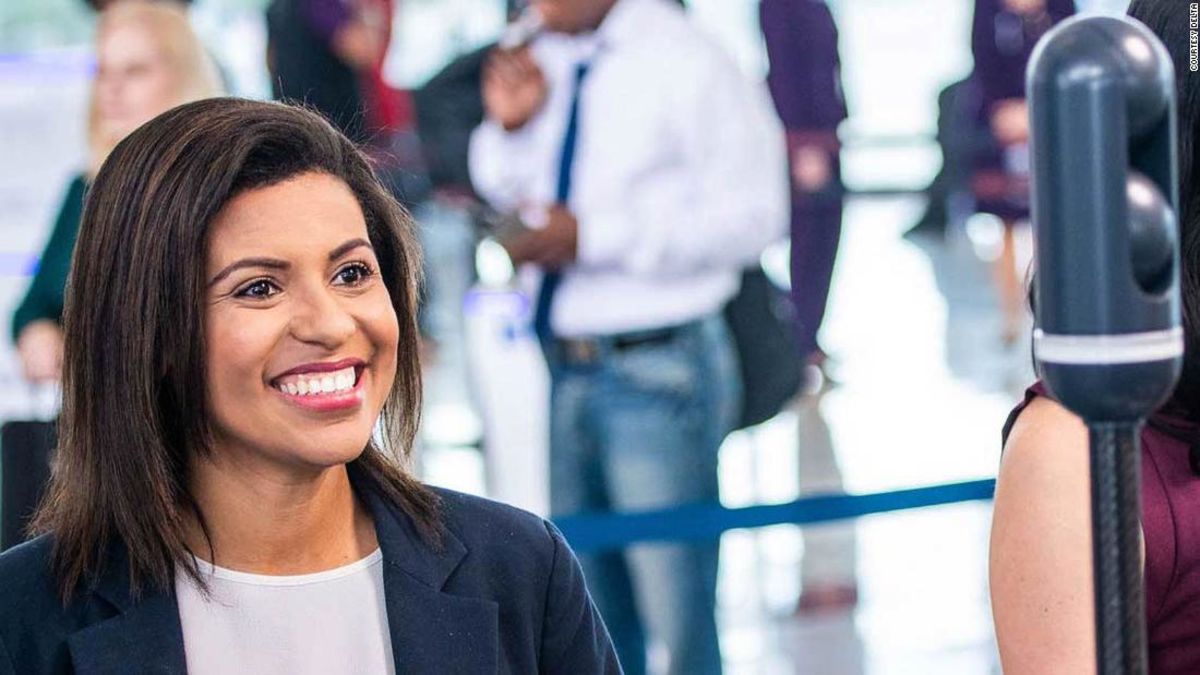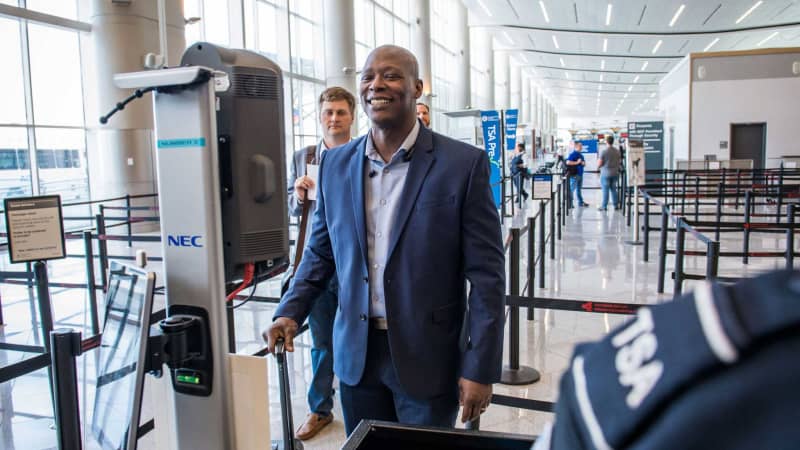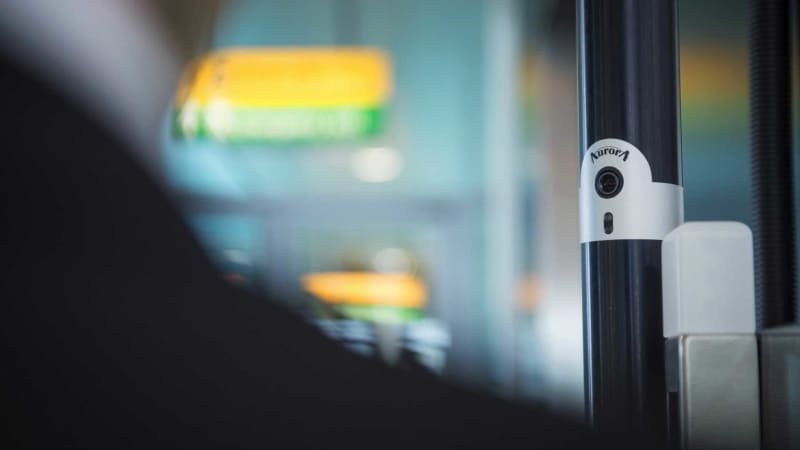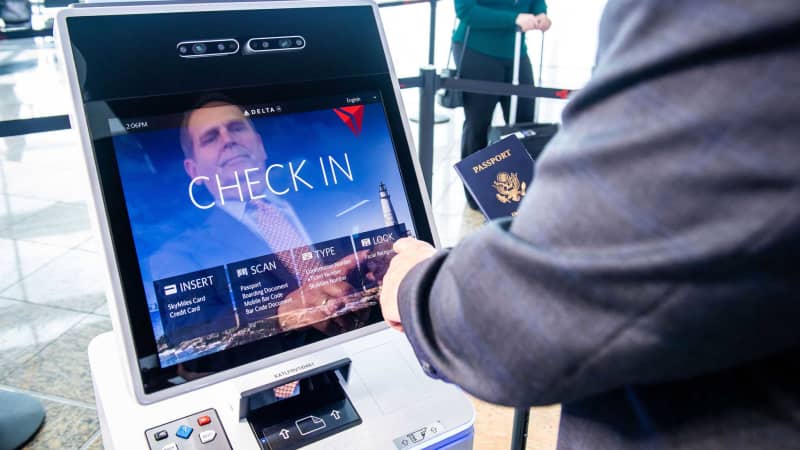(CNN) — Instead of scanning her boarding pass, the airport gate scanned her face.
In April 2019, traveler MacKenzie Fegan was left surprised and confused when she boarded a JetBlue flight from the United States to Mexico, without handing over her passport, or travel documents.
Before she’d even sat down on her airplane seat, Fegan, a New York-based journalist, fired off a Tweet to JetBlue, asking the airline to explain the process.
About 10 minutes later, Fegan received a reply:
“You’re able to opt out of this procedure, MacKenzie. Sorry if this made you feel uncomfortable,” read the response.
Implicit in the Tweet was the answer that, yes, on some JetBlue flights, facial recognition and biometric technology is used — seemingly to speed up boarding, and sift out security threats.
Fegan’s initial Tweet received over 8,500 likes, sparking a thread where passengers voiced privacy concerns and debated the pros and cons of a technology that’s becoming omnipresent in airports across the world.
“We are increasingly moving towards this type of automation — personal data and biometric data being available to companies and to corporations,” says Fegan.
“I had a lot of questions, I think everybody should have a lot of questions.”
Biometrics explained
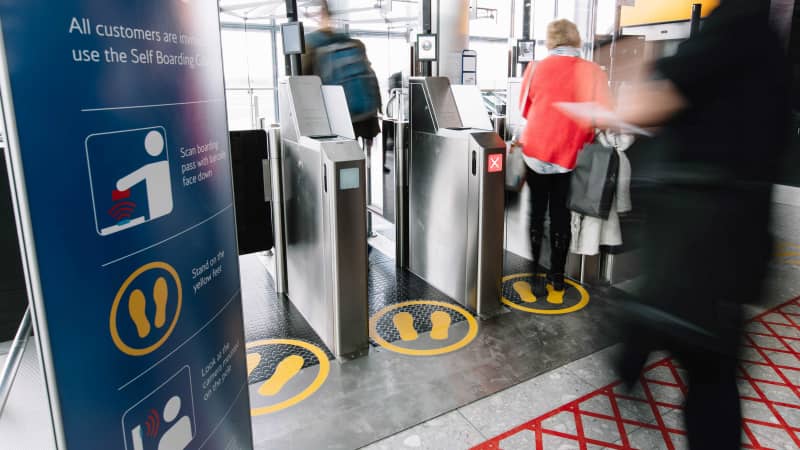
British Airways has been self-boarding passengers at Heathrow for some time.
Courtesy British Airways
Biometric technology describes tech that uses your physiological characteristics — think, the iPhone thumbprint that lets you use Apple Pay or unlock your phone without a password.
Other examples include iris recognition, fingerprints and facial recognition.
These all seem to have become ubiquitous in recent years, but the technology’s not new. It’s not even new to airports.
Raoul Cooper, British Airways’ senior digital design manager, tells CNN Travel that BA — alongside other airlines flying domestically to and from London’s Heathrow Airport — has been using facial recognition on domestic travelers for about eight or nine years.
At Terminal 5 and Terminal 2, international travelers and domestic travelers mix in the common departure lounge.
“We do have to, as a result of that, separate our customers in some way — so that you don’t have international travelers getting on to a domestic flight, especially if they’re in transit — they could, in effect, jump the border,” explains Cooper.
“So we have to put the right use of technology in and around there to stop that from happening.”
Cooper lays out how facial technology works for BA customers at Heathrow. When a customer arrives at the airport and goes through the first security checkpoint, their facial image is “grabbed.”
“We grab your face, and we associate it to your boarding pass,” he explains.
“[The camera] is looking at the face and taking a number of measurements and building out what we call a biometric template. And that is kind of like the algorithmic side or the mathematical representation of your face, and that allows us to run algorithms on it.”
When passengers board their domestic flight, another camera will take a snapshot of their face, and then sync up the picture it takes of them as they board, with the earlier shot from when they arrived at the airport.
“If the two match within the right sort of realms of accuracy, we say great — that does correlate and it correlates with the boarding pass, and so the customer can pass through.”
If there’s a “hiccup” with the system, as Cooper puts it, BA staff will go through the secondary process — checking documents, calling over an agent if necessary.
This system’s been in operation for domestic travelers in the UK for more than a decade. More recently, BA introduced self boarding gates and investigating the use of facial recognition for international travelers.
The British carrier partnered up with US Customs and Border Protection (CBP) to trial facial recognition for international flights between Orlando and London.
Cooper stresses the speed advantages.
“One of our best times was boarding 240 customers in about 10 minutes, without causing massive queues on the aircraft,” he says.
Facial recognition in the US
On the other side of the Atlantic the US government has been using facial recognition for the past 20 years or so, although it’s only ramped up biometric boarding recently.
Biometric entry-exit has been recommended — but not widely enforced — since the Illegal Immigration Reform and Immigrant Responsibility Act of 1996.
The 9/11 Commission Report — an official report into the 2001 terror attacks on New York and Washington — concluded that a biometric entry-exit screening system for foreign nationals was integral to US national security.
Since the mid-noughties, any non-US citizen who travels to the United States gets their picture taken and fingerprints scanned on arrival.
In 2017 President Donald Trump signed an executive order to accelerate the full roll out of airport biometrics for all domestic and international travelers, something also supported by Barack Obama’s administration.
Now facial recognition’s going nationwide.
CBP told CNN Travel it’s implemented air entry facial biometric capabilities, including four pre-clearance locations, at 15 airports. Biometric air exits are in place at 22 locations.
Biometric entry involves CBP taking a live image of the traveler at the inspection booth upon arrival in the United States. This image is compared to photos CBP already has stored, including passport and visa photos.
“Both the live image and the gallery photograph are displayed to the CBP officer along with the traveler’s biographic data,” explains CBP. “Foreign travelers who normally provide fingerprints and a photograph to enter the United States no longer have to provide their fingerprints as their identity is confirmed through the streamlined facial comparison process.”
As for biometric exit, that’s what Mackenzie Fegan experienced with JetBlue. Before an international flight departs, CBP generates a gallery of images of each traveler on board the aircraft. Again, these images are taken from historical photographs such as the traveler’s passport, visa or photographs from previous entries.
At the departure gate, a new photograph is taken via a camera “either operated by CBP or approved partners such as airlines and airport authorities,” confirms CBP.
The new image is compared to the old image. If there’s any issue, the officials revert to manual passport inspection.
CBP tells CNN the process takes two seconds, at an accuracy rate of 98%.
“It’s token-less, it’s paperless. It’s a two to three second process. It’s quicker and efficient,” says John Wagner, deputy executive assistant commissioner of field operations at CBP.
Customer privacy implications
For the advocates of airport biometrics, the promise of increased security and ease of travel are a win-win.
Its backers include the World Travel and Tourism Council, a global body which promotes the tourism industry.
“Our priorities are to help increase security and facilitate travel — and that is where biometrics is very important technology for us and is going to help us to move towards that direction,” says Gloria Guevara, the WTTC’s CEO.
Wagner also speaks about biometrics helping to eradicate air travel “anxiety,” while Cooper says that because British Airways staff aren’t spending all their time checking passports, they’re better able to give attention to those who need it, such as disabled passengers, nervous fliers or families with children.
Plus, as all the airlines insist — you can opt out.
But what happens if you refuse to be scanned?
Cooper, of British Airways, says the system isn’t “forced on anybody.”
It’s the same, he says, in the United States. If someone declines facial recognition, they’ll have their boarding pass and passport checked manually instead.
Fegan says she feels she was pushed into biometric boarding without her consent.
“What was most alarming to me was that there was no notification of what was going to happen,” she says, although she admits it’s possible she missed an announcement or some signage.
Some skeptics might suggest it’s pointless to protest — since we live in an era of Big Data. When the government and so many private companies already have so much information on us, why not give them one more piece of the puzzle — particularly if it makes travel smoother?
“The thing is that I willingly have given much of my personal data, biometrics included, to the US government, I’m a frequent traveler, I signed up for our Global Entry program and TSA PreCheck,” says Fegan.
The difference is, she says, is she entered those after making an “informed decision.”
“I weighed, is it going to be worth it for me to skip the three hours immigration line every time I come back into the country, in order to hand over this biometrics in to the US government?” says Fegan.
She also voices concerns about the fact JetBlue is a private company, wondering what the carrier might do with her biometrics.
“It just seemed like it was inching toward Big Brother surveillance in a way that I did not consent to,” Fegan says. “The government should not be acting unilaterally and definitely should not be acting together with corporations to decide what is best for the consumer.”
Protests and concerns
Some civilian groups have also expressed uneasiness about airport facial recognition.
“We see facial recognition as a uniquely dangerous form of surveillance technology,” Evan Greer, deputy director at Fight for the Future, tells CNN Travel. “We see it as similar to nuclear or biological weapons in terms of the potential harm that it poses to human society,”
Greer says the group is worried that American airports and airlines are a “testing ground” for biometrics, and the technology will soon become commonplace across the United States and internationally.
The organization also expresses concern that airport-based facial recognition will target undocumented people traveling domestically within the United States — and echos Fegan’s fear that commercial airlines could sell the data.
Greer also says opting out of the procedure is likely much harder than it sounds.
“You can imagine that people who are people of color, or religious minorities who are already subjected to additional surveillance and harassment at airports might be more hesitant to opt out of a process like this, even if they are concerned about it,” says Greer.
Evan Greer, deputy director at Fight for the Future
“But I think that the idea that the airlines say that this is opt out, and that solves all the problems with it, is just disingenuous, and doesn’t reflect the actual impact on people who are forced to use it at the airport.”
The false matches, said the ACLU, were disproportionality of people of color.
Jay Stanley, senior policy analyst with the ACLU, also expresses concern about the power wielded by biometric technology.
Stanley suggests to CNN Travel the need for “carefully considered checks and balances to make sure that it’s not abused or results in people being unfairly identified as threats, or turned into a mass surveillance tool.”
Wagner, of CBP, acknowledges these concerns about facial recognition doubling up as an airport-wide surveillance program — he’s keen to reassure travelers concerned about this scrutiny.
“We’re not creating new inspection checkpoints, or we’re not creating a new requirement to establish your identity in a public space where there isn’t one today,” he says.
“What we’re doing is simply automating an identity check that’s already required by statute, using technology that allows us to do it easier and quicker, for both the government and for the airlines and for the travelers themselves.”
The picture that’s taken is only compared to previous images that the traveler has already provided to the government, he says.
“We’re not taking that new picture and running it against any law enforcement watch lists or any type of other facial recognition databases,” Wagner adds.
In the United States, photographs taken of US nationals entering the country are deleted within 24 hours. Photographs of foreign nationals are kept in a secure repository called IDENT.
Photographs taken of US citizens upon departure are deleted with 12 hours of identity verification, while photographs taken of non-US citizens are saved for up to 14 days.
As for the concerns that airlines’ might misuse or sell the data, the carriers are adamant that doesn’t and will not happen.
“We don’t grab, hold or even touch any of that biometrical or identity data,” says Cooper, on behalf of British Airways. “It’s done purely by the federal government and we don’t have any desire to hold on to that information.”
Cooper also says BA is committed to keeping passengers up to speed with what’s going on. They’ve got signs up and around boarding, they make announcements and staff will answer any questions travelers may have.
“That’s important,” he says. “People care about their data and care about their biometrics, they might not call it their biometric, they might have other name for it. But it’s important to people, we take that very seriously and we give that information to people and we will reassure them as best we can.”
American carriers JetBlue and Delta declined CNN Travel’s request for an interview.
A JetBlue representative forwarded a self-boarding Q&A, which reiterates how the process works, explains that customers do not have to participate and says the airline doesn’t store the photos.
Delta also directed CNN towards its latest press release, stressing facial recognition is optional.
What about the security advantages of facial recognition at airports?
Aviation security expert Jeffrey C. Price, a professor of aviation management at Metropolitan State University of Denver, tells CNN Travel there are “tremendous security benefits that come with facial recognition.”
It’s much harder to falsify identification that’s associated with your face, Price explains.
“This will make known and suspected terrorists, and wanted criminals less likely to go to locations such as an airport where this technology is in place,” he says.
Price says, however, that the technology is not without threat.
“The biggest security concern I have with the technology is the ability to hack into the databases and retrieve an individuals biometric data,” he says.
“Facial recognition, like all the other biometrics, rely on system inputs such as fingerprints, or measurements of data points on an individual hand or face. It is possible to feed a reader of the data stream (i.e. data points) from an authorized user, directly into the device by physically disrupting or interfering with the fiber optics line, or in some cases, using an internet connection.”
Still, the security expert says he doesn’t see this threat deterring airlines or airports.
“As someone in the cyber security industry once told me, there are two kinds of people, those that have been hacked and those that just don’t know it yet,” says Price.
“I think the routine updates to our protections and the occasional hacking of our personal information is a reality we must now simply live with.”
The future of travel?
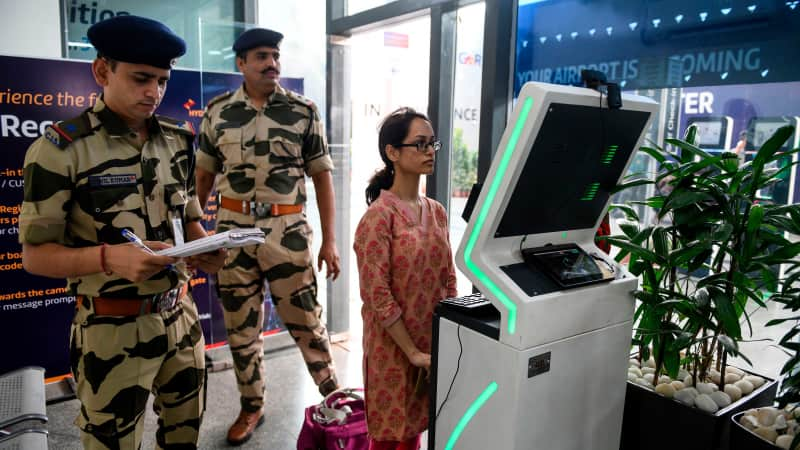
Facial recognition is taking place at India’s Rajiv Gandhi International Airport.
NOAH SEELAM/AFP/Getty Images
So is biometric technology the future of traveling? It certainly seems likely that within the next few years it’ll become the norm.
In China, facial recognition is widespread — including, but not limited to airports.
In Amsterdam, Hong Kong carrier Cathay Pacific is triaiing biometric boarding, while Tokyo Narita International Airport is aiming for a “One ID” ene-to-end biometric boarding process by spring 2020. India’s Rajiv Gandhi International Airport in Hyderabad launched a facial recognition system this year.
Heathrow is undergoing what the airport calls “a biometric revolution” — plowing £50 million (over $61 million) into making the airport a biometric hub.
Meanwhile London’s Gatwick Airport recently announced plans to roll out auto-boarding technology on eight departure gates in its North Terminal, following an extensive renovation.
“I think it makes good sense to use the modern technology to answer those questions,” says British Airways’ Cooper. “But to do it in a responsible and ethically sound way, as well.”
Air travel might be under more scrutiny as sustainability advocates push for alternative modes of transport, but the industry is still thriving — and officials say they need to work out best practices for handling volumes of people.
“As we try to drive more people through those airports, we’re looking for better ways to more efficiently use the resources and the physical infrastructure that’s there,” says Wagner.
“And if we can modernize manual processes by automating them through the use of the biometric technology, I think that’s what governments around the world are really after.”
